Which Of The Following Is Not A Natural Service Function Of Tsunamis?
Major adverse event resulting from natural processes of the Earth
This article is about natural disasters. For the natural hazards that might lead to disasters, see Natural hazard.
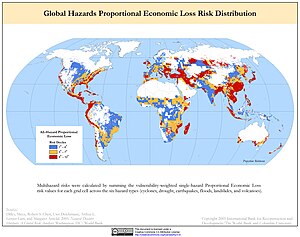
Global multihazard proportional economic loss by natural disasters as cyclones, droughts, earthquakes, floods, landslides and volcanoes
A natural disaster is a major adverse event resulting from natural processes of the Earth; examples include firestorms, duststorms, floods, hurricanes, tornadoes, volcanic eruptions, earthquakes, tsunamis, storms, and other geologic processes. A natural disaster can cause loss of life or damage property,[1] and typically leaves some economic damage in its wake, the severity of which depends on the affected population's resilience and on the infrastructure available.[2]
In modern times, the divide between natural, man-made and man-accelerated is quite difficult to draw[3] [4] [5] with human choices like architecture,[6] fire,[7] [8] resource management[8] [9] or even climate change[10] potentially playing a role. An adverse event will not rise to the level of a disaster if it occurs in an area without vulnerable population.[11] [12] In a vulnerable area, however, such as Nepal during the 2015 earthquake, an adverse event can have disastrous consequences and leave lasting damage, which can take years to repair. The disastrous consequences also impact the mental health of effected communities often leading to post-traumatic symptoms. These increased emotional experiences can be supported through collective processing, leading to resilience and increased community engagement.[13]
Geological disasters


Global death from natural disasters


Global damage cost from natural disasters

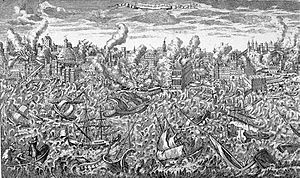
Avalanches and landslides
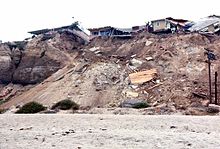
A landslide is described as an outward and downward slope movement of an abundance of slope-forming materials including rock, soil, artificial materials, or a combination of these.[14]
During World War I, an estimated 40,000 to 80,000 soldiers died as a result of avalanches during the mountain campaign in the Alps at the Austrian-Italian front. Many of the avalanches were caused by artillery fire.[15] [16]
Earthquakes
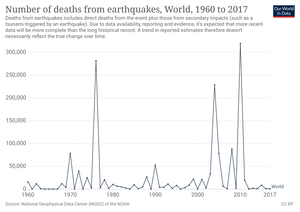
Global Number of deaths from earthquake (1960-2017)

Global number of recorded earthquake events
An earthquake is the result of a sudden release of energy in the Earth's crust that creates seismic waves. At the Earth's surface, earthquakes manifest themselves by vibration, shaking, and sometimes displacement of the ground. Earthquakes are caused by slippage within geological faults. The underground point of origin of the earthquake is called the seismic focus. The point directly above the focus on the surface is called the epicenter. Earthquakes by themselves rarely kill people or wildlife — it is usually the secondary events that they trigger, such as building collapse, fires, tsunamis and volcanic eruptions, that cause death. Many of these can possibly be avoided by better construction, safety systems, early warning and planning.[ citation needed ]
Sinkholes
When natural erosion, human mining or underground excavation makes the ground too weak to support the structures built on it, the ground can collapse and produce a sinkhole. For example, the 2010 Guatemala City sinkhole, which killed fifteen people, was caused when heavy rain from Tropical Storm Agatha, diverted by leaking pipes into a pumice bedrock, led to the sudden collapse of the ground beneath a factory building.[ citation needed ]
Volcanic eruptions
Volcanoes can cause widespread destruction and consequent disaster in several ways. One hazard is the volcanic eruption itself, with the force of the explosion and falling rocks able to cause harm. Lava may also be released during the eruption of a volcano; as it leaves the volcano, it can destroy buildings, plants and animals due to its extreme heat. In addition, volcanic ash may form a cloud (generally after cooling) and settle thickly in nearby locations. When mixed with water, this forms a concrete-like material. In sufficient quantities, ash may cause roofs to collapse under its weight. Even small quantities will harm humans if inhaled — it has the consistency of ground glass and therefore causes laceration to the throat and lungs. Volcanic ash can also cause abrasion damage to moving machinery such as engines. The main killer of humans in the immediate surroundings of a volcanic eruption is pyroclastic flows, consisting of a cloud of hot ash which builds up in the air above the volcano and rushes down the slopes when the eruption no longer supports the lifting of the gases. It is believed that Pompeii was destroyed by a pyroclastic flow. A lahar is a volcanic mudflow or landslide. The 1953 Tangiwai disaster was caused by a lahar, as was the 1985 Armero tragedy in which the town of Armero was buried and an estimated 23,000 people were killed.[ citation needed ]
Volcanoes rated at 8 (the highest level) on the Volcanic Explosivity Index are known as supervolcanoes. According to the Toba catastrophe theory, 75,000 to 80,000 years ago, a supervolcanic eruption at what is now Lake Toba in Sumatra reduced the human population to 10,000 or even 1,000 breeding pairs, creating a bottleneck in human evolution,[17] and killed three-quarters of all plant life in the northern hemisphere. However, there is considerable debate regarding the veracity of this theory. The main danger from a supervolcano is the immense cloud of ash, which has a disastrous global effect on climate and temperature for many years.
Duststorms
Duststorm is a spread of dust in arid areas.
Hydrological disasters

A hydrological disaster is a violent, sudden and destructive change either in the quality of Earth's water or in the distribution or movement of water on land below the surface or in the atmosphere.
Floods
A flood is an overflow of water that 'submerges' land.[18] The EU Floods Directive defines a flood as a temporary covering of land that is usually dry with water.[19] In the sense of 'flowing water', the word may also be applied to the inflow of the tides. Flooding may result from the volume of a body of water, such as a river or lake, becoming higher than usual, causing some of the water to escape its usual boundaries.[20] While the size of a lake or other body of water will vary with seasonal changes in precipitation and snow melt, a flood is not considered significant unless the water covers land used by humans, such as a village, city or other inhabited area, roads or expanses of farmland.
Tsunami
A tsunami (plural: tsunamis or tsunami; from Japanese: 津波, lit. "harbour wave"; English pronunciation: /tsuːˈnɑːmi/), also known as a seismic sea wave or tidal wave, is a series of waves in a water body caused by the displacement of a large volume of water, generally in an ocean or a large lake. Tsunamis can be caused by undersea earthquakes such as the 2004 Boxing Day tsunami, or by landslides such as the one in 1958 at Lituya Bay, Alaska, or by volcanic eruptions such as the ancient eruption of Santorini. On March 11, 2011, a tsunami occurred near Fukushima, Japan and spread through the Pacific Ocean.
Limnic eruptions
A limnic eruption, also known as a lake overturn, occurs when a gas, usually CO2, suddenly erupts from deep lake water, posing the threat of suffocating wildlife, livestock and humans. Such an eruption may also cause tsunamis in the lake as the rising gas displaces water. Scientists believe that landslides, explosions or volcanic activity can trigger such an eruption. To date, only two limnic eruptions have been observed and recorded. In 1984, in Cameroon, a limnic eruption in Lake Monoun caused the deaths of 37 nearby residents; at nearby Lake Nyos in 1986, a much larger eruption killed between 1,700 and 1,800 people by asphyxiation.
Meteorological disasters
Tropical cyclone
Typhoon, cyclone, cyclonic storm and hurricane are different names for the same phenomenon: a tropical storm that forms over an ocean. It is characterized by strong winds, heavy rainfall and thunderstorms. The determining factor on which term is used is based on where the storm originates. In the Atlantic and Northeast Pacific, the term "hurricane" is used; in the Northwest Pacific, it is referred to as a "typhoon"; a "cyclone" occurs in the South Pacific and Indian Ocean.
The deadliest hurricane ever was the 1970 Bhola cyclone; the deadliest Atlantic hurricane was the Great Hurricane of 1780, which devastated Martinique, St. Eustatius and Barbados. Another notable hurricane is Hurricane Katrina, which devastated the Gulf Coast of the United States in 2005. Hurricanes may become more intense and produce more heavy rainfall as a consequence of human-induced climate change.
Blizzards
Blizzards are severe winter storms characterized by heavy snow and strong winds. When high winds stir up snow that has already fallen, it is known as a ground blizzard. Blizzards can impact local economic activities, especially in regions where snowfall is rare. The Great Blizzard of 1888 affected the United States, when many tons of wheat crops were destroyed. In Asia, the 1972 Iran blizzard and the 2008 Afghanistan blizzard, were the deadliest blizzards in history; in the former, an area the size of Wisconsin was entirely buried in snow. The 1993 Superstorm originated in the Gulf of Mexico and traveled north, causing damage in 26 American states as well as in Canada and leading to more than 300 deaths.[21]
Hailstorms
Main article: Hail
Hailstorms are precipitation in the form of ice that does not melt before it hits the ground. Hailstones usually measure between 5 and 150 mm ( 1⁄4 and 6 in) in diameter. A particularly damaging hailstorm hit Munich, Germany, on July 12, 1984, causing about $2 billion in insurance claims.
Ice storms
An ice storm is a type of winter storm characterized by freezing rain. The U.S. National Weather Service defines an ice storm as a storm which results in the accumulation of at least 1⁄4 inch (6.35 mm) of ice on exposed surfaces.
Cold waves
A cold wave, known in some regions as a cold snap or cold spell, is a weather phenomenon that is distinguished by a cooling of the air. Specifically, as used by the U.S. National Weather Service, a cold wave is a rapid fall in temperature within a 24-hour period, requiring substantially increased protection to agriculture, industry, commerce and social activities. The precise criterion for a cold wave is determined by the rate at which the temperature falls and the minimum to which it falls. This minimum temperature is dependent on the geographical region and time of year.
Heat waves
A heat wave is a period of unusually and excessively hot weather. The worst heat wave in recent history was the European Heat Wave of 2003. A summer heat wave in Victoria, Australia, created conditions which fuelled the massive bushfires in 2009. Melbourne experienced three days in a row of temperatures exceeding 40 °C (104 °F), with some regional areas sweltering through much higher temperatures. The bushfires, collectively known as "Black Saturday", were partly the act of arsonists. The 2010 Northern Hemisphere summer resulted in severe heat waves which killed over 2,000 people. The heat caused hundreds of wildfires which led to widespread air pollution and burned thousands of square kilometers of forest.
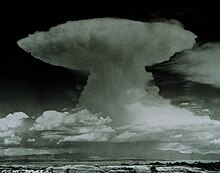
Droughts
Drought is the unusual dryness of soil caused by levels of rainfall significantly below average over a prolonged period. Hot and dry winds, shortage of water, high temperatures and consequent evaporation of moisture from the ground can also contribute to conditions of drought. Droughts result in crop failure and shortages of water.
Well-known historical droughts include the 1997–2009 Millennium Drought in Australia which led to a water supply crisis across much of the country. As a result, many desalination plants were built for the first time (see list). In 2011, the State of Texas lived under a drought emergency declaration for the entire calendar year and suffered severe economic losses.[22] The drought caused the Bastrop fires.
Thunderstorms
Severe storms, dust clouds and volcanic eruptions can generate lightning. Apart from the damage typically associated with storms, such as winds, hail and flooding, the lightning itself can damage buildings, ignite fires and kill by direct contact. Especially deadly lightning incidents include a 2007 strike in Ushari Dara, a remote mountain village in northwestern Pakistan, that killed 30 people;[23] the crash of LANSA Flight 508 which killed 91 people; and a fuel explosion in Dronka, Egypt, caused by lightning in 1994 which killed 469 people.[24] Most deaths from lightning occur in the poorer countries of the Americas and Asia, where lightning is common and adobe mud brick housing provides little protection.[25]
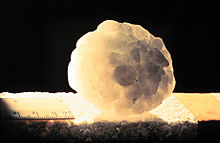
A large hailstone, about
6 cm (2+ 1⁄2 in) in diameter
Tornadoes
A tornado is a violent and dangerous rotating column of air that is in contact with both the surface of the Earth and a cumulonimbus cloud, or, in rare cases, the base of a cumulus cloud. It is also referred to as a twister or a cyclone,[26] although the word cyclone is used in meteorology in a wider sense to refer to any closed low pressure circulation. Tornadoes come in many shapes and sizes but typically take the form of a visible condensation funnel, the narrow end of which touches the Earth and is often encircled by a cloud of debris and dust. Most tornadoes have wind speeds of less than 180 km/h (110 mph), are approximately 75 m (250 ft) across, and travel a few kilometers before dissipating. The most extreme tornadoes can attain wind speeds of more than 480 km/h (300 mph), stretch more than 3 km (2 mi) across, and stay on the ground for perhaps more than 100 km (60 mi).[27] [28] [29]
Fire-storms
Firestorms are produced in events associated with extreme heat such as intense forest fires or volcanic eruptions. Local weather conditions may also cause local wind vortices creating a phenomenon known as a fire tornado.
Wildfires
Wildfires are large fires which often start in wildland areas. Common causes include lightning and drought but wildfires may also be started by human negligence or arson. They can spread to populated areas and thus be a threat to humans and property, as well as wildlife. Notable wildfires include the 1871 Peshtigo Fire in the United States, which killed at least 1700 people, and the 2009 Victorian bushfires in Australia.[30] [31] [32] [33] [34]
Space disasters

Fallen trees caused by the Tunguska meteoroid of the Tunguska event in June 1908.
Impact events and airburst
Asteroids that impact the Earth have led to several major extinction events, including one which created the Chicxulub crater 64.9 million years ago and is associated with the extinction of the dinosaurs. Scientists estimate that the likelihood of death for a human from a global impact event is comparable to the probability of death from an airliner crash.[ citation needed ]
No human death has been definitively attributed to an impact event, but the 1490 Ch'ing-yang event in which over 10,000 people may have died has been linked to a meteor shower. Even asteroids and comets that burn up in the atmosphere can cause significant destruction on the ground due to the air burst explosion; notable air bursts include the Tunguska event in June 1908, which devastated 2,137 km2 (825 sq mi) of Siberian countryside, and the Chelyabinsk meteor on 15 February 2013, which caused widespread property damage in the city of Chelyabinsk and injured about 1,200 people.[35]
Solar flare
A solar flare is a phenomenon in which the Sun suddenly releases a much larger amount of solar radiation than normal. Solar flares are unlikely to cause any direct human injury but can destroy electrical equipment. The potential of solar storms to cause disaster was seen during the 1859 Carrington event, which disrupted the telegraph network, and the March 1989 geomagnetic storm which blacked out Quebec. Some major known solar flares include the X20 event on August 16, 1989,[36] and a similar flare on April 2, 2001.[36] The most powerful flare ever recorded occurred on November 4, 2003 (estimated at between X40 and X45).[37]
Protection by international law
The United Nations Office for the Coordination of Humanitarian Affairs was formed by General Assembly Resolution 44/182.
Under the Convention on the Rights of Persons with Disabilities, "States Parties shall take, in accordance with their obligations under international law, including international humanitarian law and international human rights law, all necessary measures to ensure the protection and safety of persons with disabilities in situations of risk, including situations of armed conflict, humanitarian emergencies and the occurrence of natural disasters."[38] The 1998 UN Guiding Principles on Internal Displacement and 2009 Kampala Convention also protect people displaced due to natural disasters.[39] [40]
Location
According to the UN, Asia-Pacific is the world's most disaster prone region.[41] According to ReliefWeb, a person in Asia-Pacific is five times more likely to be hit by a natural disaster than someone living in other regions.[42]
Impacts on vulnerable groups
Women
Because of the social, political and cultural context of many places throughout the world, women are often disproportionately affected by disaster.[43] In the 2004 Indian Ocean tsunami, more women died than men, partly due to the fact that fewer women knew how to swim.[43] During and after a natural disaster, women are at increased risk of being affected by gender based violence and are increasingly vulnerable to sexual violence. Disrupted police enforcement, lax regulations, and displacement all contribute to increased risk of gender based violence and sexual assault.[43] Women who have been affected by sexual violence are at a significantly increased risk of sexually transmitted infections, unique physical injuries and long term psychological consequences.[43] All of these long-term health outcomes can prevent successful reintegration into society after the disaster recovery period.[43]
In addition to LGBT people and immigrants, women are also disproportionately victimised by religion-based scapegoating for natural disasters: fanatical religious leaders or adherents may claim that a god or gods are angry with women's independent, freethinking behaviour, such as dressing 'immodestly', having sex or abortions.[44] For example, Hindutva party Hindu Makkal Katchi and others blamed women's struggle for the right to enter the Sabarimala temple for the August 2018 Kerala floods, purportedly inflicted by the angry god Ayyappan.[45] [46] After an earthquake struck on 26 September 2019 near Istanbul, Turkey, Islamists blamed the disaster on women, and harassed random women in the streets; a similar Islamist backlash against women occurred after the 1999 İzmit earthquake.[47] In response to Iranian Islamic cleric Kazem Seddiqi's accusation of women dressing immodestly and spreading promiscuity being the cause of earthquakes, American student Jennifer McCreight organised the Boobquake event on 26 April 2010: she encouraged women around the world to participate in dressing immodestly all at the same time while performing regular seismographic checks to prove that such behaviour in women causes no significant increase in earthquake activity.[48]
During and after natural disasters, routine health behaviors become interrupted. In addition, health care systems may have broken down as a result of the disaster, further reducing access to contraceptives.[43] Unprotected intercourse during this time can lead to increased rates of childbirth, unintended pregnancies and sexually transmitted infections (STIs).[43] [49] Methods used to prevent STIs (such as condom use) are often forgotten or not accessible during times surrounding a disaster. Lack of health care infrastructure and medical shortages hinder the ability to treat individuals once they acquire an STI. In addition, health efforts to prevent, monitor or treat HIV/AIDS are often disrupted, leading to increased rates of HIV complications and increased transmission of the virus through the population.[43]
Pregnant women are one of the groups disproportionately affected by natural disasters. Inadequate nutrition, little access to clean water, lack of health-care services and psychological stress in the aftermath of the disaster can lead to a significant increase in maternal morbidity and mortality. Furthermore, shortage of healthcare resources during this time can convert even routine obstetric complications into emergencies.[50] During and after a disaster, women's prenatal, peri-natal and postpartum care can become disrupted.[49] Among women affected by natural disaster, there are significantly higher rates of low birth weight infants, preterm infants and infants with low head circumference.[43] [51]
Political consequences
Everyone is desperate for food and water. There's no food, water, or gasoline. The government is missing.
— Lian Gogali Aid worker following 2018 Sulawesi earthquake and tsunami.[52]
Disasters stress government capacity, as the government tries to conduct routine as well as emergency operations.[53] Some theorists of voting behavior propose that citizens update information about government effectiveness based on their response to disasters, which affects their vote choice in the next election.[54] Indeed, some evidence, based on data from the USA, reveals that incumbent parties can lose votes if citizens perceives them as responsible for a poor disaster response[55] or gain votes based on perceptions of well-executed relief work.[56] The latter study also finds, however, that voters do not reward incumbent parties for disaster preparedness, which may end up affecting government incentives to invest in such preparedness.[56] Other evidence, however, also based on the USA, finds that citizens can simply backlash and blame the incumbent for hardship following a natural disaster, causing the incumbent party to lose votes.[57] One study in India finds that incumbent parties extend more relief following disasters in areas where there is higher newspaper coverage, electoral turnout, and literacy --- the authors reason that these results indicate that incumbent parties are more responsive with relief to areas with more politically-informed citizens who would be more likely to punish them for poor relief efforts.[58]
Violent conflicts within states can exacerbate the impact of natural disasters by weakening the ability of states, communities and individuals to provide disaster relief. Natural disasters can also worsen ongoing conflicts within states by weakening the capacity of states to fight rebels.[59] [60]
In Chinese and Japanese history, it has been routine for era names or capital cities and palaces of emperors to be changed after a major natural disaster, chiefly for political reasons such as association with hardships by the populace and fear of upheaval (i.e. in East Asian government chronicles, such fears were recorded in a low profile way as an unlucky name or place requiring change).[61]
Statistics
Between 1995 and 2015, according to the UN's disaster-monitoring system, the greatest number of natural disasters occurred in America, China and India.[62]
In 2012, there were 905 natural disasters worldwide, 93% of which were weather-related disasters. Overall costs were US$170 billion and insured losses $70 billion. 2012 was a moderate year. 45% were meteorological (storms), 36% were hydrological (floods), 12% were climatological (heat waves, cold waves, droughts, wildfires) and 7% were geophysical events (earthquakes and volcanic eruptions). Between 1980 and 2011 geophysical events accounted for 14% of all natural catastrophes.[63]
According to 2019 WHO report countries with the highest share of disability-adjusted life years (DALY) lost due to natural disasters are Bahamas, Haiti, Zimbabwe and Armenia (probably mainly due to Spitak Earthquake).[64] [65]
See also
- Act of God
- Civil defense
- Disaster risk reduction
- Emergency management
- Environmental disaster
- Environmental emergency
- List of environmental disasters
- Natural hazard
- Urban Search and Rescue
- World Conference on Disaster Risk Reduction
- Wild animal suffering
References
- ^ "Billion-Dollar Weather and Climate Disasters: Overview | National Centers for Environmental Information (NCEI)". www.ncdc.noaa.gov.
- ^ G. Bankoff, G. Frerks, D. Hilhorst (eds.) (2003). Mapping Vulnerability: Disasters, Development and People. ISBN1-85383-964-7. CS1 maint: multiple names: authors list (link) [ page needed ]
- ^ "Why natural disasters aren't all that natural". openDemocracy. 2020-11-26. Retrieved 2020-12-29 .
- ^ Gould, Kevin A.; Garcia, M. Magdalena; Remes, Jacob A.C. (1 December 2016). "Beyond 'natural-disasters-are-not-natural': the work of state and nature after the 2010 earthquake in Chile". Journal of Political Ecology. 23 (1): 93. doi:10.2458/v23i1.20181.
- ^ Smith, Neil (2006-06-11). "There's No Such Thing as a Natural Disaster". Items . Retrieved 2020-12-29 .
- ^ Coburn, Andrew W.; Spence, Robin JS; Pomonis, Antonios (1992). "Factors determining human casualty levels in earthquakes: mortality prediction in building collapse" (PDF). Proceedings of the tenth world conference on earthquake engineering. 10. pp. 5989–5994. ISBN978-90-5410-060-7.
- ^ "Wildfire Causes and Evaluations (U.S. National Park Service)". NPS.gov Homepage (U.S. National Park Service). 2018-11-27. Retrieved 2020-12-29 .
- ^ a b DeWeerdt, Sarah (2020-09-15). "Humans cause 96% of wildfires that threaten homes in the U.S." Anthropocene . Retrieved 2020-12-29 .
- ^ Smil, Vaclav (18 December 1999). "China's great famine: 40 years later". BMJ. 319 (7225): 1619–1621. doi:10.1136/bmj.319.7225.1619. PMC1127087. PMID 10600969.
- ^ McGuire, Bill (2012). Waking the Giant: How a changing climate triggers earthquakes, tsunamis, and volcanoes. Oxford University Press. ISBN978-0-19-959226-5. [ page needed ]
- ^ D. Alexander (2002). Principles of Emergency planning and Management. Harpended: Terra publishing. ISBN1-903544-10-6.
- ^ B. Wisner; P. Blaikie; T. Cannon & I. Davis (2004). At Risk – Natural hazards, people's vulnerability and disasters. Wiltshire: Routledge. ISBN0-415-25216-4. [ page needed ]
- ^ Kieft, J.; Bendell, J (2021). "The responsibility of communicating difficult truths about climate influenced societal disruption and collapse: an introduction to psychological research". Institute for Leadership and Sustainability (IFLAS) Occasional Papers. 7: 1–39.
- ^ Highland, Lynn. "Landslide Hazard Information". Geology.com. Geology.com. Retrieved 26 February 2017.
- ^ Lee Davis (2008). "Natural Disasters". Infobase Publishing. p.7. ISBN 0-8160-7000-8
- ^ "Avalanche!". WorldWar1.com. Retrieved 2015-01-12 .
- ^ GibbonsJan. 19, Ann (19 January 2010). "Human Ancestors Were an Endangered Species". Science. AAAS.
- ^ MSN Encarta Dictionary. Flood. Retrieved on 2006-12-28. Archived 2009-10-31.
- ^ "Directive 2007/60/EC Chapter 1 Article2".
- ^ Glossary of Meteorology (June 2000). Flood. Archived 2007-08-24 at the Wayback Machine Retrieved on 2009-01-09.
- ^ "Natural Hazards – Snow & Hail Storms". www.n-d-a.org . Retrieved 2017-02-26 .
- ^ "Billion-Dollar Weather and Climate Disasters: Events | National Centers for Environmental Information (NCEI)". www.ncdc.noaa.gov.
- ^ "Lightning kills 30 people in Pakistan's north". Reuters. 20 July 2007.
- ^ "An appraisal of underground gas storage technologies". Health and Safety Executive.
- ^ "Deadly lightning strike in Mexico reveals plight of poorest citizens". The Guardian. 31 July 2015.
- ^ "Definition of CYCLONE". www.merriam-webster.com.
- ^ Wurman, Joshua (2008-08-29). "Doppler on Wheels". Center for Severe Weather Research. Archived from the original on 2007-02-05. Retrieved 2009-12-13 .
- ^ "Hallam Nebraska Tornado". National Weather Service. National Oceanic and Atmospheric Administration. 2005-10-02. Retrieved 2009-11-15 .
- ^ Roger Edwards (2006-04-04). "The Online Tornado FAQ". National Weather Service. National Oceanic and Atmospheric Administration. Archived from the original on 2006-09-29. Retrieved 2006-09-08 .
- ^ "2009 Victorian Bushfires | Victorian Government". www.vic.gov.au . Retrieved 2021-04-25 .
- ^ US Department of Commerce, NOAA. "The Peshtigo Fire". www.weather.gov . Retrieved 2021-04-25 .
- ^ Editors, History com. "Massive fire burns in Wisconsin". HISTORY . Retrieved 2021-04-25 . CS1 maint: extra text: authors list (link)
- ^ corporateName=National Museum of Australia; address=Lawson Crescent, Acton Peninsula. "National Museum of Australia - Black Saturday bushfires". www.nma.gov.au . Retrieved 2021-04-25 . CS1 maint: multiple names: authors list (link)
- ^ "Bushfire - Black Saturday, Victoria, 2009 | Australian Disaster Resilience Knowledge Hub". knowledge.aidr.org.au . Retrieved 2021-04-25 .
- ^ Tauzin, Benoit; Debayle, Eric; Quantin, Cathy; Coltice, Nicolas (2013-07-19). "Seismoacoustic coupling induced by the breakup of the 15 February 2013 Chelyabinsk meteor". Geophysical Research Letters. 40 (14): 3522–3526. Bibcode:2013GeoRL..40.3522T. doi:10.1002/grl.50683. ISSN 0094-8276.
- ^ a b "Sun Unleashes Record Superflare, Earth Dodges Solar Bullet". ScienceDaily. April 4, 2011. Retrieved 2011-08-27 .
- ^ "Biggest Solar Flare ever recorded". National Association for Scientific and Cultural Appreciation. 2004. Archived from the original on August 4, 2011. Retrieved 2011-08-27 .
- ^ "Article 11 – Situations of risk and humanitarian emergencies". United Nations. 13 December 2006. Retrieved 3 September 2021.
- ^ Terminski, Bogumil (2012). Towards recognition and protection of forced environmental migrants in the public international law: Refugee or IDPs umbrella? (Report).
- ^ "2009 Kampala Convention on IDPs" (PDF). UNHCR. May 2019. Retrieved 3 September 2021.
- ^ Asia-Pacific World's Most Disaster-Prone Region
- ^ "FACTBOX-Asia-Pacific: the world's most disaster-prone region - World". ReliefWeb.
- ^ a b c d e f g h i Nour, Nawal N (2011). "Maternal Health Considerations During Disaster Relief". Reviews in Obstetrics and Gynecology. 4 (1): 22–27. PMC3100103. PMID 21629495.
- ^ Leighann Lord (1 October 2019). "The easiest way to respond to a natural disaster? Blame God or global warming". The Guardiuan . Retrieved 28 September 2019.
- ^ "Kerala flood blamed on women's entry into Sabarimala by Hindu Makkal Katchi". The New Indian Express. 15 August 2018. Retrieved 28 September 2019.
- ^ Asmita Nandy (20 August 2018). "Hate Mongers on Twitter Blamed Women, Beef, Muslims, Christians and Communism for Causing the Kerala Floods". The Quint . Retrieved 28 September 2019.
- ^ "Istanbul hit by earthquake, Islamists blame women". Ahval. 26 September 2019. Retrieved 28 September 2019.
- ^ Pat Pilcher (26 April 2010). "Islamic cleric causes Boobquake". The New Zealand Herald . Retrieved 28 September 2019.
- ^ a b Harville, Emily; Xiong, Xu; Buekens, Pierre (November 2010). "Disasters and Perinatal Health: A Systematic Review". Obstetrical & Gynecological Survey. 65 (11): 713–728. doi:10.1097/OGX.0b013e31820eddbe. PMC3472448. PMID 21375788.
- ^ Meyers, Talya (23 December 2019). "Pregnant women are particularly vulnerable to disasters". Direct Relief . Retrieved 21 September 2020.
- ^ American College of Obstetricians and Gynecologists Committee on Health Care for Underserved Women (June 2010). "Committee Opinions No. 457: Preparing for Disasters: Perspectives on Women". Obstetrics & Gynecology. 115 (6): 1339–1342. doi:10.1097/AOG.0b013e3181e45a6f. PMID 20502312.
- ^ "Indonesia earthquake and tsunami: All the latest updates". www.aljazeera.com.
- ^ Clarke, Daniel J.; Dercon, Stefan (2016). Dull Disasters? How planning ahead will make a difference. Oxford University Press. ISBN978-0-19-878557-6.
- ^ Ashworth, Scott; Bueno de Mesquita, Ethan; Friedenberg, Amanda (May 2017). "Accountability and Information in Elections". American Economic Journal: Microeconomics. 9 (2): 95–138. doi:10.1257/mic.20150349. ISSN 1945-7669.
- ^ Gasper, John T.; Reeves, Andrew (April 2011). "Make It Rain? Retrospection and the Attentive Electorate in the Context of Natural Disasters". American Journal of Political Science. 55 (2): 340–355. doi:10.1111/j.1540-5907.2010.00503.x. JSTOR 23025055.
- ^ a b Healy, Andrew; Malhotra, Neil (August 2009). "Myopic Voters and Natural Disaster Policy". American Political Science Review. 103 (3): 387–406. doi:10.1017/S0003055409990104. ISSN 1537-5943. S2CID 32422707.
- ^ Achen, Christopher; Bartels, Larry (2017-08-29). Blind Retrospection: Electoral Responses to Droughts, Floods, and Shark Attacks. Princeton University Press. doi:10.1515/9781400888740-007. ISBN978-1-4008-8874-0.
- ^ Besley, Timothy; Burgess, Robin (2001-05-01). "Political agency, government responsiveness and the role of the media". European Economic Review. 15th Annual Congress of the European Economic Association. 45 (4): 629–640. doi:10.1016/S0014-2921(01)00133-7. ISSN 0014-2921.
- ^ Nel, Philip; Righarts, Marjolein (1 March 2008). "Natural Disasters and the Risk of Violent Civil Conflict". International Studies Quarterly. 52 (1): 159–185. CiteSeerX10.1.1.408.6031. doi:10.1111/j.1468-2478.2007.00495.x. JSTOR 29734228.
- ^ Brancati, Dawn (October 2007). "Political Aftershocks: The Impact of Earthquakes on Intrastate Conflict". Journal of Conflict Resolution. 51 (5): 715–743. doi:10.1177/0022002707305234. JSTOR 27638575. S2CID 154551510. SSRN2558790. ProQuest 224558525.
- ^ Author, No (September 3, 2018). "Name of Japan's next era to avoid initial letters used to refer to past four eras". The Japan Times.
- ^ "Weather-related disasters are increasing". The Economist. 29 Aug 2017.
- ^ Natural Catastrophes in 2012 Dominated by U.S. Weather Extremes Archived 2013-07-02 at the Wayback Machine Worldwatch Institute May 29, 2013
- ^ "Global health estimates: Leading causes of DALYs".
- ^ "2019 WHO DALY report data".
External links
- "World Bank's Hazard Risk Management". World Bank. Archived from the original on 2010-04-09. Retrieved 2007-06-30 .
- "Billion-dollar Weather and Climate Disasters". NCDC.
- "Disaster News Network". Archived from the original on 2006-11-05. Retrieved 2006-11-05 . US news site focused on disaster-related news.
- "EM-DAT International Disaster Database". Archived from the original on 2008-08-11. Retrieved 2006-11-05 . Includes country profiles, disaster profiles and a disaster list.
- "Global Disaster Alert and Coordination System". European Commission and United Nations website initiative.
- "Natural Disaster and Extreme Weather. Searchable Information Center". Ebrary.
- Natural hazard research from Bushfire and Natural Hazards CRC
Which Of The Following Is Not A Natural Service Function Of Tsunamis?
Source: https://en.wikipedia.org/wiki/Natural_disaster
Posted by: ramirezbispecephe60.blogspot.com

0 Response to "Which Of The Following Is Not A Natural Service Function Of Tsunamis?"
Post a Comment